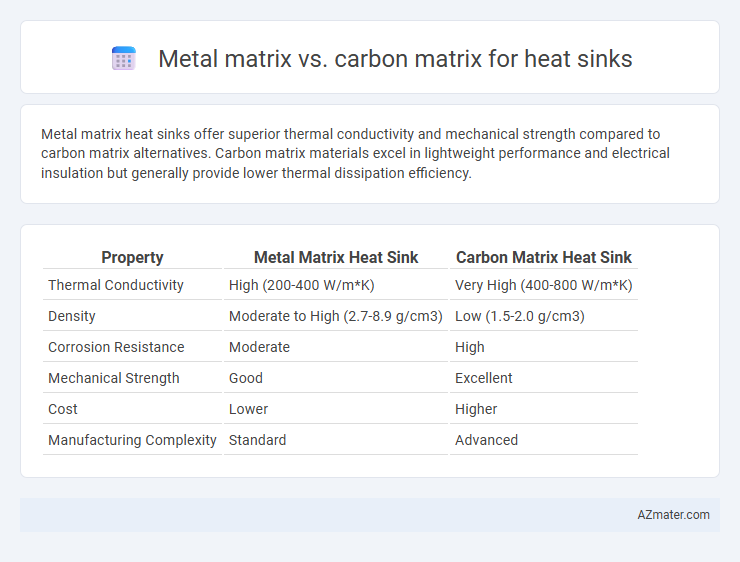Metal matrix heat sinks offer superior thermal conductivity and mechanical strength compared to carbon matrix alternatives. Carbon matrix materials excel in lightweight performance and electrical insulation but generally provide lower thermal dissipation efficiency.
Table of Comparison
| Property | Metal Matrix Heat Sink | Carbon Matrix Heat Sink |
|---|---|---|
| Thermal Conductivity | High (200-400 W/m*K) | Very High (400-800 W/m*K) |
| Density | Moderate to High (2.7-8.9 g/cm3) | Low (1.5-2.0 g/cm3) |
| Corrosion Resistance | Moderate | High |
| Mechanical Strength | Good | Excellent |
| Cost | Lower | Higher |
| Manufacturing Complexity | Standard | Advanced |
Introduction to Heat Sink Materials
Heat sinks commonly use metal matrices such as aluminum and copper due to their high thermal conductivity, enhancing heat dissipation in electronic devices. Carbon matrix materials, including graphite and carbon composites, offer lower density and excellent thermal conductivity with superior weight-to-performance ratio ideal for lightweight applications. Selecting between metal and carbon matrices depends on thermal management requirements, mechanical strength, cost, and application-specific constraints.
Overview of Metal Matrix Heat Sinks
Metal matrix heat sinks, typically composed of aluminum or copper matrices reinforced with ceramic fibers or particles, offer superior thermal conductivity compared to carbon matrix heat sinks, enabling efficient heat dissipation in high-power electronic devices. These metal-based composites exhibit excellent mechanical strength, corrosion resistance, and machinability, making them ideal for applications requiring both structural integrity and thermal management. Advanced fabrication techniques such as powder metallurgy and infiltration enhance the thermal performance and reliability of metal matrix heat sinks in automotive, aerospace, and electronics cooling systems.
Understanding Carbon Matrix Heat Sinks
Carbon matrix heat sinks offer superior thermal conductivity and lightweight characteristics compared to traditional metal matrix counterparts, making them ideal for high-performance electronic cooling. Their anisotropic heat transfer properties enable efficient dissipation of heat along specified directions, enhancing device reliability and lifespan. Advanced carbon composites also provide excellent corrosion resistance and mechanical strength, ensuring durability in demanding thermal management applications.
Thermal Conductivity Comparison
Metal matrix heat sinks, commonly made from aluminum or copper, exhibit thermal conductivities ranging from 200 to 400 W/m*K, significantly enhancing heat dissipation in electronic components. In contrast, carbon matrix materials such as graphite composites and graphene-infused polymers can achieve thermal conductivities upwards of 500 to 2000 W/m*K, offering superior thermal management by rapidly spreading heat across the surface. The higher thermal conductivity of carbon matrices makes them particularly effective for applications requiring lightweight, high-performance heat sinks with efficient heat transfer.
Mechanical Strength and Durability
Metal matrix heat sinks offer superior mechanical strength and durability due to their dense atomic structure and resistance to deformation under high temperatures. Carbon matrix heat sinks provide excellent thermal conductivity with lightweight properties but may exhibit lower mechanical strength and susceptibility to mechanical wear over time. Combining both materials in hybrid composites can optimize thermal performance while maintaining structural integrity for long-term durability.
Weight and Density Considerations
Metal matrix heat sinks, typically composed of aluminum or copper, offer higher thermal conductivity but have greater density and weight compared to carbon matrix composites. Carbon matrix materials, such as graphite or carbon fiber composites, provide significantly lower density, reducing overall weight while maintaining adequate thermal performance for weight-sensitive applications. Selecting between metal and carbon matrices requires balancing thermal management needs against stringent weight constraints in aerospace or portable electronics.
Cost and Manufacturing Complexity
Metal matrix heat sinks, such as those made from aluminum or copper, offer lower manufacturing complexity due to established casting and machining processes, resulting in cost-effective production for large volumes. Carbon matrix composites, including graphite or carbon fiber-reinforced polymers, present higher material costs and require specialized manufacturing techniques like chemical vapor deposition or advanced molding, increasing overall complexity and expense. Cost-efficiency and scalability favor metal matrix heat sinks, while carbon matrix options serve niche applications demanding superior thermal conductivity and weight reduction despite increased production challenges.
Corrosion and Environmental Resistance
Metal matrix heat sinks, commonly made from aluminum or copper, offer high thermal conductivity but are susceptible to corrosion in harsh environments without protective coatings. Carbon matrix heat sinks, such as those using graphite or carbon fiber composites, exhibit superior resistance to corrosion and environmental degradation due to their chemically inert nature. This inherent stability makes carbon matrices ideal for applications requiring long-term performance in corrosive or extreme environmental conditions.
Application Suitability and Industry Use
Metal matrix heat sinks, primarily composed of aluminum or copper alloys, offer superior thermal conductivity and mechanical strength, making them ideal for high-performance electronics and automotive industries where efficient heat dissipation is critical. Carbon matrix heat sinks, often utilizing graphite or carbon fiber composites, provide excellent thermal management with reduced weight, preferred in aerospace and telecommunications for lightweight and high thermal efficiency applications. Industry adoption depends on factors like operational temperatures, weight constraints, and cost-effectiveness, with metal matrices favored in heavy-duty environments and carbon matrices chosen for advanced, lightweight thermal solutions.
Future Trends in Heat Sink Material Development
Metal matrix composites continue to dominate heat sink applications due to their superior thermal conductivity and mechanical strength, with ongoing research targeting enhanced alloy compositions and nano-scale reinforcements to improve heat dissipation efficiency. Carbon matrix materials, particularly graphene and carbon nanotube composites, are emerging as promising candidates for next-generation heat sinks, offering ultra-high thermal conductivity, lightweight properties, and excellent thermal stability under extreme operating conditions. Future trends emphasize hybrid materials combining metal and carbon matrices to leverage the advantages of both, aiming for customizable thermal management solutions in high-performance electronics and electric vehicle systems.

Infographic: Metal matrix vs Carbon matrix for Heat sink
 azmater.com
azmater.com